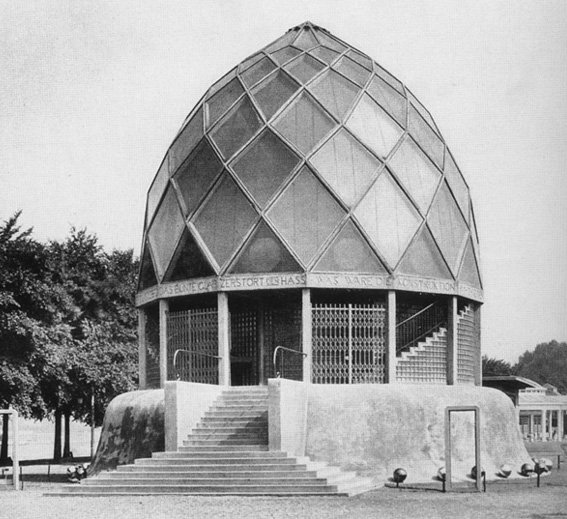Stealth translation on Wikipedia, in Interlingua: Bruno Taut's Glass Pavilion of the Deutscher Werkbund Exhibition in 1914, in Cologne, Germany
Tuesday, July 15, 2008

Once again another translation into Interlingua to try to get attention paid attention to IALs. This one as well will be going on the front page of the English Wikipedia in the Did you know... section in...a bit over an hour from now. I'll probably be asleep then. Thus far I see no response whatsoever in translating all these articles but I'm still hopeful.
Roma non esseva construte in un sol die.
This one is a bit better than the one yesterday because it is the DYK article with a small image attached to it, which I suspect will get more traffic than the other five or so. Here it is in English and Interlingua (only the parts I translated):
| English | Interlingua |
|---|---|
The Glass Pavilion built in 1914 by Bruno Taut was a prismatic glass dome structure at the Cologne Deutscher Werkbund Exhibition. [1][2] The structure was a brightly colored landmark at the exhibition and constructed using concrete and glass. The concrete structure had inlaid colored glass plates on the facade that acted like mirrors. Taut described his little temple of beauty as "...reflections of light whose colors began at the base with a dark blue and rose up through moss green and golden yellow to culminate at the top in a luminous pale yellow." | Le Pavilion de Vitro construite in 1914 per Bruno Taut esseva un prismatic cupola de vitro al Deutscher Werkbund Exhibition in Köln, Germania. Le structura esseva un puncto de referimento con colores brillante al exhibition, contruite usante beton e vitro. Le structura de beton habeva incrustate plattos de vitro colorate al faciada, agiente como speculos. Taut describeva su pauc templo de beltate como "...reflexiones de lumine cuje colores comenciava del base con un blau obscur, e se elevante a verde musco e jalne auree, culminante al summitate con un luminose jalne pallide." |
| Taut's Glass Pavilion is his best known single building achievement. He built it for the association of the German glass industry specifically for the 1914 exhibition. They financed the structure that was considered a house of art. The structure was made at the time when expressionism stood highest in Germany. There are only black and white photographs known of the building that were taken in 1914. The building was destroyed soon after the exhibition since it was an exhibition building only and not built for practical use. | Le Pavilion to Vitro de Taut es su complimento le plus cognoscite. Ille lo construeva pro le association del industria de vitro german specificamente pro le exhibition de 1914. Illos financiava le structura, le qual esseva considerate como un casa de arte. Le structura esseva create in le tempore quando expressionismo esseva situate in su plus alte position. Nunc existe solo photographias de nigre e blanc del edificio que esseva facite in 1914. Le edificio esseva destruite tosto post le exhibition, proque illo non esseva facite pro usage practic. |
| The Glass Pavilion was a pineapple shaped multi-faceted polygonal designed rhombic structure. It was a fourteen-sided base constructed of thick glass bricks used on the exterior walls devoid of rectangles. Taut's Glass Pavilion was the first building of glass bricks of importance. | Le Pavilion de Vitro esseva un structura rhombic con un figura de ananas e un designo polygonal de multe facettias. Illo habeva un base construite de briccas de vitro dense usate al muros exterior, sin rectangulos. Le Pavilion de Vitro de Taut esseva le prime edificio de importantia construite de briccas de vitro. |
Eight hours later, for some reason this article has been spending a lot of time on the main page. Usually they change around every four hours but this one has been up for eight. I have no problem with that. Here's what it looks like:









0 comments:
Post a Comment